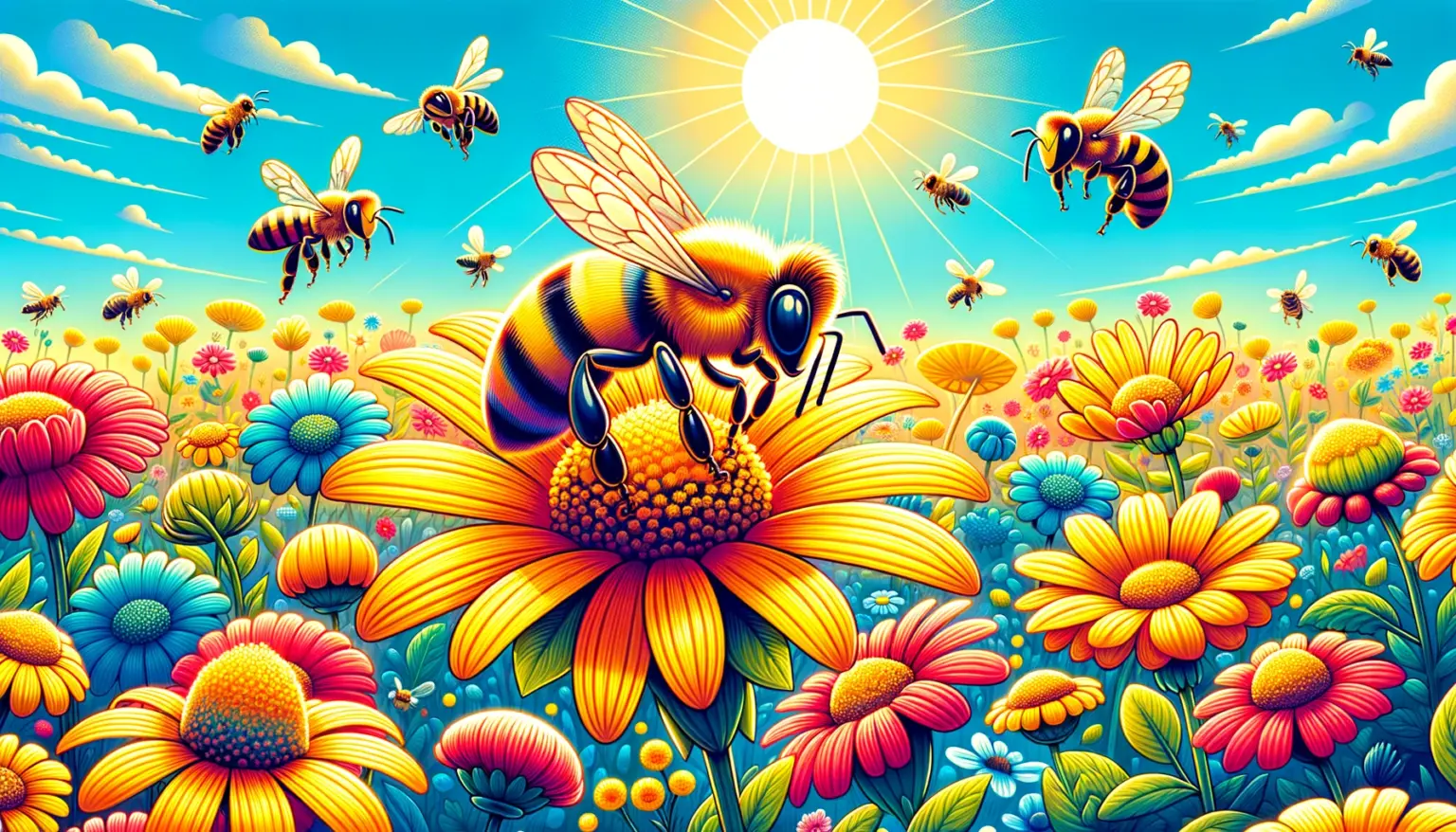Every May 20th, the world comes together to celebrate World Bee Day, a day dedicated to recognizing the essential role bees play in our ecosystems and our food supply. These small but mighty insects are responsible for pollinating about one-third of the food we eat, making them indispensable to agriculture and biodiversity. Despite their crucial role, bees face numerous threats that endanger their populations and, consequently, our food security and natural environments.
World Bee Day was established by the United Nations in 2017 to raise awareness about the importance of bees and to promote actions that protect them. This article delves into the significance of bees, the challenges they face, and how we can all contribute to their conservation.
The Importance of Bees: Pollination Powerhouses
Pollination and Food Production Bees are among the most efficient pollinators on the planet, responsible for the pollination of a vast array of plants, including fruits, vegetables, nuts, and seeds. This process is vital for the production of many of the foods we consume daily. Without bees, many of these crops would see significantly reduced yields, leading to a decrease in food variety and an increase in prices.
Maintaining Biodiversity Beyond agriculture, bees play a pivotal role in maintaining the health and diversity of ecosystems. They facilitate the reproduction of many wild plants, which in turn support a range of other wildlife. This interconnected web ensures the stability and resilience of our natural habitats. In essence, bees are not just beneficial for human agriculture but are also essential for the broader ecological balance.
Economic Contributions The economic value of bee pollination is immense. In the United States alone, the agricultural output that depends on bee pollination is estimated to be worth over $15 billion annually. Globally, this figure rises to hundreds of billions of dollars. Thus, protecting bee populations is not only an environmental imperative but also a significant economic concern.
Threats to Bee Populations: A Closer Look
Pesticides and Chemical Exposure One of the most pressing threats to bee populations is the widespread use of pesticides. These chemicals can be lethal to bees or impair their ability to forage, reproduce, and defend against diseases. Neonicotinoids, in particular, have been shown to have devastating effects on bee health, leading to increased mortality rates and weakened colonies.
Habitat Loss and Fragmentation Urbanization and intensive agricultural practices have led to the destruction of many natural habitats that bees rely on. The reduction in wildflower meadows, hedgerows, and other foraging areas has left bees with fewer resources to sustain their colonies. Habitat fragmentation further isolates bee populations, making it harder for them to survive and thrive.
Climate Change Impacts Climate change is altering the environments in which bees live. Changes in temperature and precipitation patterns can disrupt the availability of flowers, affecting the timing and abundance of food resources. Additionally, extreme weather events can destroy habitats and directly harm bee populations, further compounding their struggle for survival.
Diseases and Parasites Bees are also vulnerable to a range of diseases and parasites, such as the Varroa mite. These mites attach to bees, weakening them and making them more susceptible to viruses. Disease outbreaks can decimate entire colonies, adding another layer of challenge to already stressed populations.
World Bee Day: A Global Call to Action
History and Significance World Bee Day was initiated by the Republic of Slovenia and endorsed by the United Nations to raise awareness about the vital role of bees and other pollinators. The date, May 20th, was chosen in honor of Anton Janša, a pioneer of modern beekeeping, born on this day in 1734. The aim is to highlight the importance of bees, the threats they face, and the need for sustainable practices to protect them.
Goals and Objectives The primary goals of World Bee Day are to educate the public about the importance of bees, promote actions that protect and support bee habitats, and encourage collaboration between governments, organizations, and individuals. By spreading knowledge and advocating for change, World Bee Day seeks to foster a global movement towards bee conservation.
How to Celebrate and Support Bees: Practical Steps
Personal Actions Individuals can play a significant role in supporting bee populations. Planting a variety of bee-friendly flowers, avoiding the use of pesticides in gardens, and providing water sources can create a welcoming environment for bees. Supporting local beekeepers by purchasing their honey and other products also helps maintain healthy bee populations.
Community Initiatives Communities can come together to create green spaces, such as urban gardens and wildflower meadows, that provide essential foraging areas for bees. Educational programs in schools and local organizations can raise awareness and inspire collective action. Community beekeeping projects can also foster engagement and provide practical benefits for local ecosystems.
Policy Advocacy Advocating for policies that protect bees is crucial. This includes supporting legislation that restricts harmful pesticides, promotes sustainable agricultural practices, and funds research into bee health. Encouraging local governments to implement bee-friendly initiatives, such as creating pollinator corridors, can also make a significant impact.
Success Stories and Ongoing Efforts: Inspiring Examples
Case Studies of Success There are numerous examples of successful initiatives that have made a positive impact on bee populations. For instance, the rewilding of urban areas in some cities has led to a resurgence of local bee populations. Conservation projects that restore natural habitats and introduce wildflower planting schemes have also shown promising results.
Innovative Research and Technology Research into bee health and behavior continues to uncover new insights that can aid in their conservation. Technological advancements, such as the development of bee-friendly pesticides and the use of monitoring systems to track bee populations, are helping to mitigate some of the challenges bees face. Collaborative efforts between scientists, farmers, and conservationists are essential to driving these innovations forward.
Conclusion: Our Shared Responsibility
As we celebrate World Bee Day, it’s crucial to remember that the responsibility of protecting bees falls on all of us. By understanding their importance, recognizing the threats they face, and taking action at both individual and collective levels, we can help ensure that bees continue to thrive. Their survival is intertwined with the health of our ecosystems and our own well-being.
Let World Bee Day be a reminder and a call to action: plant a flower, support a beekeeper, advocate for change. Together, we can create a world where bees and humans coexist in harmony, securing a sustainable future for all.
10 Interesting Facts about Bees
- Bees Communicate Through Dance: Honeybees perform a “waggle dance” to inform their hive mates about the direction and distance of food sources.
- Bees Have Five Eyes: Bees have two large compound eyes and three small ocelli eyes on the top of their heads, helping them navigate and detect light.
- Bees Can Recognize Human Faces: Research has shown that bees can remember and recognize human faces, similar to how they recognize flowers.
- Only Female Bees Sting: Male bees, or drones, do not have stingers. Only female worker bees and queens can sting.
- Bees Are Vital for Chocolate: The cacao tree, which produces chocolate, relies on tiny midges, a type of fly, but bees also play a role in pollinating other plants that support the cacao ecosystem.
- A Single Bee Makes 1/12 Teaspoon of Honey: Throughout her lifetime, a worker bee produces only about 1/12 teaspoon of honey, highlighting the collective effort of the hive.
- Bees Fly 55,000 Miles for One Pound of Honey: Collectively, bees from a hive fly the equivalent of over two times around the Earth to gather enough nectar for one pound of honey.
- Bees Have Been Around for Millions of Years: Fossil evidence suggests that bees have existed for around 100 million years, making them ancient pollinators.
- Bees Are Colorblind to Red: Bees cannot see the color red but can see ultraviolet light, which helps them locate nectar in flowers.
- Bees Can Fly at 15 Miles Per Hour: Despite their small size, bees are fast flyers, reaching speeds of up to 15 miles per hour while foraging.












This article on World Bee Day is buzzing with great information! A wonderful read.
Bee day celebration
Very informative!
World Bee Day is crucial for raising awareness. This article is a great reminder to protect our pollinators.
World Bee Day is important for conservation. This piece captures the significance of celebrating and protecting our pollinators well. Thanks for the informative read!
The page about World Bee Day is very informative and engaging. It offers a detailed look at the importance and significance of bees, along with some interesting facts and ways to protect our pollinators. The information is well-organized and easy to read, making it a pleasure to navigate. This site is a fantastic resource for anyone wanting to learn more about World Bee Day.
This page about World Bee Day is fantastic. It emphasizes the importance of bees and offers practical tips on how to protect them. The site is filled with engaging facts and beautiful images, making it both educational and enjoyable to read. A must-visit for nature lovers.